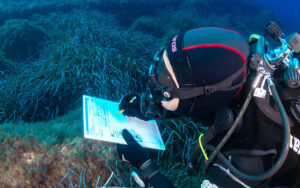In the framework of the Interreg Euro-MED project MPA4Change, a list of Atlantic indigenous and non-indigenous fish species will be soon defined as candidate indicators of climate change.
Marine organisms are subject to alteration in environmental conditions, due to both natural variability and climate change. Overall, many marine fish have responded markedly different to recent increase in sea surface temperature. During the last decades, several cold adapted and temperate native species are rapidly losing their distribution and abundance. While, at the same time non-indigenous and warmer species have expanded their geographical distribution becoming established and subsequently invasive.
Climate change effects on fish distribution

A scuba diver conducting a Fish Visual Census survey – Photo by Giovanni Ombrello
As part of the MPA4Change project team, the National Research Council of Italy (CNR) together with the University of Algarve, Portugal, are currently refining the existing Fish Visual Census protocol (FVC) according to regional monitoring needs. The attempt is to update the list of target fish species as reliable indicators of climate change in the Atlantic Ocean. The focus will be on indigenous and non-indigenous fish species inhabiting the coastal waters of Marine Protected Areas (MPAs) located in the south of Portugal. The target fish species will be chosen based on their responsiveness to temperature conditions, widespread distribution and easy identification.
The list of species will be also discussed within a network of experts and then included within the climate change monitoring toolkit of the MPA4Change project. Afterwards, a new fish visual census board will be developed to assess climate change impact in MPAs. The final validated regional FVC protocol will be transferred to other MPAs or institutions that want to uptake the solutions offered through this project.
Fish visual censuses to detect climate change impacts
Monitoring is a crucial component of an MPA because it provides the necessary data required to evaluate changes in habitats and species´ communities as a result of the implementation of managed protected areas. Underwater FVC technique is a widely used methodology to assess the abundance and distribution of specific fish species, chosen as reliable indicators of climate change in MPAs. FVC protocols, like the one offered by MPA4Change, can be easily applied by scuba divers and snorkelers after a short training.
Learn more about the FVC protocol and other toolkits on climate change adaptation offered by MPA4Change project – the fine-tunned version of all toolkits will be soon available in this website. Additionally, you can follow up the project updates through our news section or by subscribing to our biannual newsletter.


